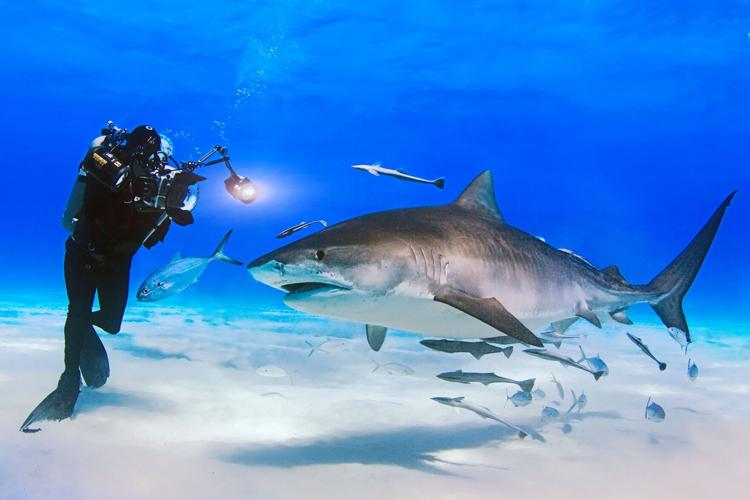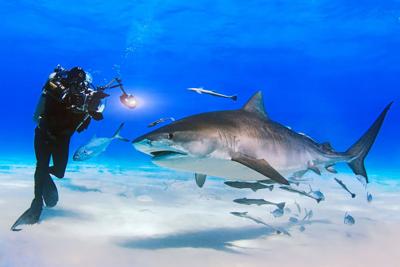On Sunday, April 30, Auditorium Theatre hosted David Doubilet and Jennifer Hayes, who shared never-before-seen photography from underwater environments and detailed their vivid experiences in a presentation called “Coral Kingdoms and Empires of Ice.” Not only are Doubilet and Hayes husband and wife, they’re also business partners, traveling the world to hidden underwater universes.
David is considered one of the most prolific living photographers at National Geographic Magazine, and Jennifer is an aquatic biologist and globally published photojournalist. Just three weeks after being in Antarctica, the pair made their way to Chicago and brought their earth shattering stories with them.

David Doubilet and Jennifer Hayes | Courtesy of Kelly Stremmel
Introducing the couple on stage was Shedd Aquarium’s Vice Presentation of Conservation Research Dr. Chuck Knapp, which was only fitting as Shedd Aquarium joins David and Jennifer’s global cause to save endangered sharks — keep reading to find out how.
Travel Destinations
Four locations touched on by David and Jennifer included Kimbe Bay in Papua New Guinea; “Jardines de la Reina,” or Gardens of the Queen, in Cuba; Antarctica and also St. Andrews Bay, South Georgia, in the South Atlantic; and the Gulf of St. Lawrence northeast of Maine and New Brunswick.

A diver is surrounded by barracuda in the Bismarck Sea. | Courtesy of David Doubilet
Kimbe Bay
David Doubilet deems Kimbe Bay, which sits east of Indonesia in the Coral Triangle, the “epicenter of marine biodiversity” and has visited several times. He has gone on to capture two National Geographic covers here — one famously depicting a school of barracuda forming a circle around a diver in a rarely photographed moment. Kimbe Bay is one of the few places in the world to stand the test of time and changing climates.
One of their most memorable trips was in 2013 when David was selected to contribute to National Geographic’s iconic 125th anniversary issue; they navigated back to Kimbe Bay right as a monsoon occurred, destroying $20,000 worth of equipment. They ended up diving 125 feet down to Joelle’s seamount, an underwater mountain, just to capture clear footage. Because of the serious depths, fish had never seen divers before and would follow them curiously, such as a hawksbill turtle that trailed David around the reef and even managed to wrap her flippers around his tank.

Fishermen stand in an outrigger canoe in Kimbe Bay. | Courtesy of David Doubilet
They also visited Susan’s Reef, spotting red-whipped coral, razorfish, and squid that could camouflage themselves. David recounted experiencing the sound of rain while underwater here, saying it sounded like “an old radio hissing with static.”
Gardens of the Queen
This archipelago in the southern part of Cuba is one of the few places in the Caribbean that hasn’t lost much of its coral over the last 40 years. Because of this, David refers to it as a museum under water and Jennifer calls it an aquarium in the sea, perfectly preserving the original habitat of these clear waters. David and Jennifer were both traveling on journalist visas at the time they visited Cuba — which hadn’t been open to tourism at the time — but they highly encourage everyone to go if possible.
In a most interesting yet frightening experience, the Gardens of the Queen is where David and Jennifer captured up-close shots of American crocodiles. In this area, crocodiles are quite used to divers and stick around for a couple of moments before quickly passing by.

A sea turtle baby swims in the waters of French Polynesia. | Courtesy of David Doubilet
Antarctica and St. Andrews Bay
Just northeast of the Antarctic Peninsula is what’s known as “penguin island” or St. Andrew Bay, home to 150,000 pairs of king penguins. Before coming here, David and Jennifer had just left Antarctica, where they captured photographs of leopard seals — which can skin a penguin whole. David said of Antarctica, “We came for the animals, but we stayed for the ice” as he showed pictures of the gargantuan icebergs.
Amazingly enough, the pair were even more in awe of South Georgia, calling it “an abundance of wildlife” and capturing shots of the mass of penguins all together in one frame.

Penguins hang out on an ice floe in Antarctica. | Courtesy of David Doubilet
The Gulf of St. Lawrence
Perhaps one of the most fascinating and lesser-known places is David and Jennifer’s hometown area in the Gulf of St. Lawrence, an outlet of the North American Great Lakes via the St. Lawrence River into the Atlantic Ocean.
Having studied sturgeon for her doctoral degree, Jennifer dives in these waters and captures photographs of the sturgeon here; and with many sturgeon species going extinct, she has helped with spawning sturgeon babies in the gulf, rehabilitating them, and re-releasing them into hatcheries in the river, which has resulted in their species coming close to being removed from the list that tracks possible extinctions. Beluga whales are another prominent animal that has come close to extinction in these waters, going from 10,000 to only 1,000 left.
Born on the open sea ice here are baby harp seals, whose mothers swim down in groups of several hundred from the Arctic to give birth in late February. The mothers typically abandon their pups after about 12 days to go back home, and this is when the pups shed their bright white fur coat and learn to fend for themselves. Jennifer details a memorable and touching moment of a pup and its mother swimming up to examine her. When a more aggressive male seal attempted to attack her, the female fought him and became protective of her.

A Harp Seal pup chills on top of ice in the Gulf of St. Lawrence. | Courtesy of David Doubilet
Harp seal pups must be born on ice to survive, but this year, there was no ice in the gulf. Jennifer added that this was due to climate change, which would result in this next generation of seal pups dying off. David added, “As the oceans go, so do we.”
Chicago’s Contribution to Saving Oceans
Just as David and Jennifer use their pictures and stories to create awareness around the importance of oceans and their inhabitants, Chicago is stepping up and joining worldwide forces to combat extinction of underwater wildlife.
David and Jennifer first published a story on zebra sharks becoming an endangered species due to overfishing everywhere outside of Australia, adding a point of how crucial they are to helping the ocean’s ecosystems survive. They quickly revealed that more than 100 exist in different aquariums around the world, including Chicago’s Shedd Aquarium.

David Doubilet and Jennifer Hayes on assignment together. | Courtesy of Jim Abernethy
In an effort to save these fish, 15 countries and 44 aquariums have come together under the group ReShark to raise zebra sharks in captivity and release 500 in Indonesia. This is the first global effort to combat endangered sharks, who scientists say are disappearing at alarming rates, and Chicago is proud to be part of that effort.
For more information on David Doubilet and Jennifer Hayes, check out their website, where you can view images from their trips, read their books, and even track their expeditions.














(0) comments
Welcome to the discussion.
Log In
Keep it Clean. Please avoid obscene, vulgar, lewd, racist or sexually-oriented language.
PLEASE TURN OFF YOUR CAPS LOCK.
Don't Threaten. Threats of harming another person will not be tolerated.
Be Truthful. Don't knowingly lie about anyone or anything.
Be Nice. No racism, sexism or any sort of -ism that is degrading to another person.
Be Proactive. Use the 'Report' link on each comment to let us know of abusive posts.
Share with Us. We'd love to hear eyewitness accounts, the history behind an article.